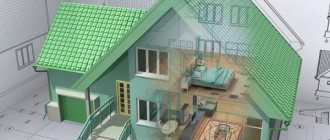House
2
A permanent residential building built on a plot of land without permission may be recognized as unauthorized construction. But in most situations, permission can be obtained after construction and the house can be registered.
The legislation defines Article 222 of the Civil Code of the Russian Federation in two scenarios when the likelihood of a house being recognized as an unauthorized construction increases:
- the object was built in violation of the norms established by law;
- construction was carried out on lands not intended for this purpose.
By obtaining permission to construct a residential property, you reduce the risk of it being recognized as an unauthorized construction.
In what cases is a building permit required?
In accordance with the requirement of clause 5 of Article 51 of the Civil Code, a permit for the construction or reconstruction of a capital construction project is required in the following cases:
- the work will be carried out on a land plot within the boundaries of a specially protected natural area;
- the object is located on land provided to the subsoil user;
- a space infrastructure facility or the use of nuclear energy is being built or reconstructed;
- work will be carried out in relation to hydraulic structures, air and railway transport facilities, border defense and security facilities of the country.
The permit is issued by the relevant authorized body.
Do I need to register an extension to a house on my own land?
An extension to a residential building must be documented because:
- the total area of the object changes. New parameters must be registered in case the house is subsequently sold, inherited, etc. It is important to register a new area in the case of shared ownership of a house, because the size of the shares will change;
- During construction, all construction standards must be observed, including setbacks from neighboring areas. In case of violation, the extension may be assigned the status of an unbuilt building. During registration, it is assessed whether the interests of neighbors are not affected by marking the new boundaries of the property on the site plan. To do this, the cadastral engineer draws up a new cadastral passport for the house.
As a general rule, before constructing an extension, it is necessary to notify the authorized body and obtain permission for its construction. But until March 1, 2026, registration of individual housing construction objects can be carried out without such a document, under the dacha amnesty.
The procedure for obtaining a building permit for an already built house
Until 2021, to build a house, it was necessary to obtain permission from the authorized body. Currently, the approval procedure is of a notification nature . Those. Before starting work, the land owner sends a notice of intention to begin construction to the local administration.
Cancellation of notifications about the start and completion of construction
As of December 2021, amendments to Federal Laws No. 218 “On State Registration of Real Estate” and No. 340 “On Amendments to the Civil Code” came into force. In accordance with the changes, until March 1, 2026, citizens can carry out cadastral registration of a garden or residential building and register ownership of it. In this case, the following conditions must be met:
- the land plot where the house is located must have the type of permitted use of individual housing construction or private plots within the boundaries of the settlement (garden plot), as well as for gardening;
- the residential building must comply with the norms of the Civil Code specified in paragraph 39 of Art. 1 (a detached building for one family, up to 20 meters high, no more than three floors above ground);
- if the ownership of the land where the house is located is not registered in the Unified State Register of Real Estate.
For registration actions you will need to provide the following documents:
- technical plan of the house;
- declaration for real estate;
- a document proving ownership of the land.
Procedure for obtaining permission
If we are talking about a house built several years ago, then the procedure for legalizing it will be different. It involves two ways of registering property rights: administrative and judicial. In any case, it is initially necessary to go through the pre-trial decision procedure. There will be no obstacles to registering a house when the building is erected:
- on lands designated for this purpose;
- complies with building regulations, the interests and rights of other persons are not violated.
If you do not fall under the conditions described above, then the algorithm of actions will be as follows:
Step 1. The process of registering a built house begins with the receipt of an urban planning plan for the land plot (GPZU). It is needed in order to understand whether it is possible to build a permanent structure on this plot, where it can be located on the site and how it should be placed. GPZU is done on the basis of topographic survey, where you can see the location of communications passing near the site or within its boundaries.
Issued by the territorial administration based on an application submitted by the owner of the plot through the MFC. You must have a passport and an extract from the Unified State Register confirming your right to own the land plot. The plan production period is 30 calendar days.
Step 2. Even if your house has already been built, a notification is prepared as to the start of construction and submitted to the local administration. In response you receive permission or refusal. If there are no violations, the result will be positive.
Notification is issued through the MFC upon application. A response is received within seven days.
Step 3. The residential building must be assigned an address. The MFC accepts the application again. The basis will be a notification of the start of construction, an extract from the Unified State Register, and the applicant’s passport. The result is an order from the local administration to assign an address.
Step 4. To register the structure, you need to obtain a technical plan. For this purpose, an agreement is concluded with a cadastral engineer. The cost of work averages 10 thousand rubles. A specialist visits the site, measures corner points and internal layout. Then he prepares a technical plan.
Step 5. After collecting the listed documentation, a notification of completion of construction is issued. We contact the MFC again with a statement and expect a response within seven working days.
Step 6. The final stage is registering the house. Based on the application submitted to Rosreestr through the MFC, data on real estate objects will be entered into the database and the residential building will appear on the cadastral map. The result of registration will be the issuance of an extract from the Unified State Register to the owner for the house.
What is an extension to a house?
Any constructive change to an existing structure is its reconstruction (Clause 14, Article 1 of the Town Planning Code of the Russian Federation). An extension to a residential building can be either on either side, increasing its dimensions in length or width, or upward when the number of storeys changes.
An extension is considered to be an addition to the house that is not indicated in the project. It happens:
- capital - built on a foundation, occupies additional land area, has one or more common walls with the existing house;
- non-permanent - non-residential premises that do not require a foundation (veranda, canopy, porch, open terrace, etc.).
Depending on whether the extension is capital or not, the process of registering it differs. Any non-permanent construction may not be documented; this will not entail the application of sanctions to the owner. It does not fundamentally affect the design features of the house, does not infringe on the rights of neighbors, and does not create a danger to the life and health of residents.
But the legislation is constantly changing and it is unknown how difficult it will become to register such an extension in the future. Today it’s a matter of calling a cadastral engineer who will certify the new parameters of the house. Then the documents are submitted for registration along with title documents for the land and house.
A slightly different procedure if the extension is of a capital nature. Using it, you can carry out a registration set of activities even before the start of construction or do it after.
Nuances that may arise
Refusal to register may occur due to a violation of the permitted use of land or urban planning regulations. Legislation establishes the boundaries of permitted construction with the establishment of maximum setbacks from other objects. The house must be located so as not to violate the rights and interests of other persons, i.e. in the permitted building area.
In case of refusal, the land owner has the right to go to court to legalize the residential property. If the decision is positive, ownership will be registered on its basis.
FacebookVKontakte
Official website of the Supreme Court of the Russian Federation
The Supreme Court of the Russian Federation stood up to protect the rights of a resident of Krasnodar when it reviewed the results of her dispute with local officials.
The citizen intended to build a house on her own plot, but she was denied such permission. The stubborn owner started building the house anyway. In the lawsuit, officials called the house an “unauthorized construction” and asked to demolish it. The district court refused this decision to the officials, but the regional court did not agree with its colleagues, deciding that the house should be demolished. The defendant appealed to the Supreme Court of the Russian Federation. The Judicial Collegium for Civil Cases of the Supreme Court decided that the citizen’s demands were fair.
The dispute began with a lawsuit from Krasnodar officials asking to demolish a house built without permission. But in response to the officials’ demands, the defendant filed a counterclaim, in which she stated that she is the owner of the site, and the house built on it does not violate the intended use of the land, does not violate anyone’s rights, does not pose a threat to the lives of others and meets all sanitary, construction and fire safety standards. Therefore, she sees no reason to demolish the house, but asks that her ownership of the house be recognized. In the lawsuit, the citizen emphasized that she asked for a construction permit, but was not given it.
The Prikubansky District Court considered the claim of the officials and the counterclaim of the owner of the house and decided to reject both.
The Krasnodar Regional Court did not agree with the district court's decision. And, having canceled it, he made a new decision, agreeing with the demands of the officials.
But the Judicial Collegium for Civil Cases of the Supreme Court of the Russian Federation was not satisfied with such a verdict. And he explained what violations were committed during the consideration of this dispute. Our heroine’s plot was her property and had a cadastral number. Category of the site - land of settlements, permitted use - for the construction of residential buildings. The administration of one of the districts of Krasnodar refused to give the owner of the land permission to build a house. There was an on-site inspection of compliance with land legislation by the city administration. The inspection showed that a residential building was being built on our heroine’s property without a building permit. The commission drew up a protocol on bringing the citizen to administrative responsibility.
According to the conclusion of the forensic examination, the constructed facility is a residential building and complies with construction and environmental standards, as well as fire safety requirements. And it also said that the rules of land use and development “at the controversial unfinished construction site were not violated.”
The district court, denying the decision to the officials, proceeded from the fact that the citizen built a house on her property and did not violate any norms, rules, or laws. Refusing the developer's counterclaim, the district court emphasized: there was no construction permit, but the lady did not take measures to legalize the construction.
The regional court, when it overturned the decision of the district court and made a new decision, said that the owner of the site did not provide evidence that she challenged the refusal of local officials to allow construction. Therefore, “the structure under construction has signs of unauthorized construction, which is subject to demolition by the person who carried it out and at his expense.” It was with this conclusion that the Supreme Court of the Russian Federation did not agree.
He began with Article 222 of the Civil Code, which explains what “unauthorized construction” is. This name means a building or structure built on a site not provided for construction, and erected without permits in violation of rules and regulations. The same article states that the right of ownership of an unauthorized construction can be recognized by the court, but only if the property owns the site on which the “structure was created.” But to recognize ownership of a house without permission, several conditions must be met.
The first is if the developer has rights to the land on which the building stands. The second is if, on the day of going to court, the building complies with the parameters “established by the documentation on territory planning, land use and development rules.” Third, if the preservation of the building does not violate the rights and interests of other people and does not pose a threat to life.
There was a joint resolution of the Plenums of the Supreme and Arbitration Courts (N10/22 of April 29, 2010), which spoke about disputes over property rights. At the plenums the following was stated: when considering claims for recognition of ownership of an unauthorized construction, the courts should establish whether during the construction there were “significant violations of town planning and building codes and regulations, and whether such a construction poses a threat to the life and health of citizens.” And the main idea is that the lack of a construction permit cannot serve as a basis for refusing a claim for recognition of ownership of an unauthorized construction. The materials of the plenums emphasize: it is necessary to take into account whether the creator of the illegal building took “appropriate measures” to legalize it, in particular, to obtain a construction permit or an act of putting the facility into operation. And the courts must find out whether officials lawfully refused a citizen permission or commissioning. A claim for recognition of ownership of an unauthorized construction must be satisfied if the court finds that the only sign of an illegal construction was the absence of a construction permit or an act of putting the facility into operation, and the citizen tried to do this.
In our case, the court found that the citizen built a house on her own land and did not violate any rules and regulations, and her house did not create a threat to anyone. The Supreme Court emphasized: the absence of a construction permit in itself cannot serve as a basis for refusing a claim for recognition of ownership of an unfinished construction project. These circumstances were not taken into account by the appeal. This ultimately led to the court making an illegal decision.
Text: Natalia Kozlova
Rossiyskaya Gazeta - Week No. 203(7961)
How to legalize an existing capital extension
At the moment, it is possible to legalize self-construction only through the court, provided that the construction was carried out in accordance with the VRI, building standards and within permissible limits. To do this, the owner must file a claim in court, and the municipality will be the defendant. If the decision is in favor of the plaintiff, all that remains is to pay the state fee and register the changes. But refusals are not uncommon, especially if violations do occur. And refusal entails not only the demolition of the unauthorized construction, but also the payment of a fine.











